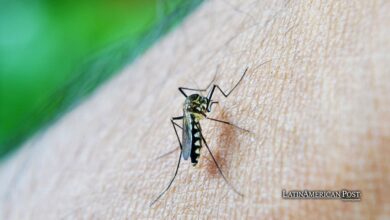Sterilized Mosquitoes: A Solution to many problems
The sterilization of mosquitoes through radiation shows positive results for the control of the most dangerous pest in the world.

Although mosquitoes are the world’s most dangerous pest, x-ray sterilization is working to eradicate them. / Photo: Pixabay
LatinAmerican Post | Juan Bacallado
Escucha este artículo
Leer en español: Mosquitos esterilizados por radiación: una solución a esta plaga
Currently, mosquitoes are the most dangerous plague on the planet, they cause of more than a million deaths annually through diseases and infections, according to DW. For this reason, the mosquito is classified as the most deadly animal, mainly due to the transmission of deadly diseases such as malaria, which kills a child in the world every minute . On the other hand, these insects spread other diseases such as Zika, dengue and yellow fever , all of which mainly affect tropical and subtropical areas on any continent, but especially in poor regions or with poor health infrastructure.
Although at the moment the main ways to eliminate and protect oneself from mosquitoes are based on periodic spraying -which also affect other insects-, use of repellants for the skin -mosquitoes develop resistance to these products-, mosquito nets and the elimination of water stagnant ; These methods are not enough and in some cases inaccessible for developing inhabitants, because of this science has been working for decades to eradicate pests by focusing on their reproductive cycle, for which the radiation sterilization method is the best known and most effective, according to hypertext review.
La criatura que causa más muertes humanas al año, no es el tiburón, las arañas o las serpientes, ni siquiera el propio ser humano, son los mosquitos. #RaFacts pic.twitter.com/HXa74tU8eM
— Rafael Poulain (@RafaelPoulain) June 5, 2018
What is irradiating an insect?
According to information from Hypertextual, the technique of sterilizing masses of insects by radiation emerged in the 1950s in the United States, when Raymond Bushland and Edward Knipling, two scientists from the United States Department of Agriculture, applied this technique against male flies that infected open wounds of cattle, which generated losses of 200 million dollars to the industry. This is why they used X-rays, getting them sterilized and almost completely eradicating this pest, causing the recovery of the livestock sector.
Today this is called the Sterile Insect Technique (SIT), which according to the International Atomic Energy Agency (IAEA) is the safest pest elimination method for the environment in which X-rays or gamma rays are applied to large masses of male offspring and then released in strategic areas. Then, despite the fact that they can mate with females and generate eggs, they are not fertile so the reproduction cycle is cut and the existence of only the irradiated species is reduced.
Esta tecnología ha sido probada en 2018 en Brasil y funciona.
Este año han reportado que funciona mucho mejor si la liberación masiva de los mosquitos machos estériles irradiados se hace desde drones. pic.twitter.com/6pZOQNC4c5
— Félix Moronta (@morontafelix) December 10, 2020
In this way, unlike other techniques, it is not necessary to introduce a predatory species that does not belong to that environment and can cause a negative environmental impact, another advantage of this method is that the use of pesticides is also avoided and costs are reduced. production as well as the health risks caused by the pest.
Irradiated mosquitoes
Although SIT is used mainly in agriculture and livestock, global health authorities such as WHO have been working for years on irradiation plans for certain species of mosquitoes that transmit diseases, so there are already insectaries where the disease is being studied. sterilization and release of irradiated mosquitoes in a controlled way to verify the results, which for the moment have been "encouraging" and more data is expected to be released en masse.
Así se ven los #mosquitos irradiados y esterilizados que se utilizan para el #ControlBiológico de estos #insectos #TIE #ControlDePlagas #Aedes pic.twitter.com/l7OxfFHPni
— Rubén Bueno (@rubueno10) December 14, 2019
These irradiated mosquitoes have already been tested in several countries such as Cuba, Brazil and Mexico where the IAEA is conducting tests with the mosquito Aedes aegypti, which transmits dengue, Zika and chikungunya, these are released through drones and land vehicles. It is estimated that in Brazil, a 55-hectare space will be occupied with these sterile mosquitoes, according to SciDev. In countries like Germany, this technique has already been used with mosquitoes since 2016 and reproduction has decreased by 15%, according to DW.
Also read: Colombia: With technology they fight diseases such as Zika or dengue
But are they radioactive?
As René Gato, coordinator of this project in Cuba, explained, although these mosquitoes are treated with radiation, they do not conserve any irradiated particles so they cannot produce radiation. On the other hand, Alfredo García, a disseminator of nuclear science and technology with a license as a nuclear operator and supervisor explained through Twitter that these irradiated mosquitoes do not affect other animals that feed on them, because although their DNA may be modified, they they do not alter the DNA of other species at all, while Felix Moronta, a graduate in Regulatory Sciences, explains that these species of mosquitoes are not pollinators, so their decrease will not impact the environment, he also justifies that these mosquitoes "are not radioactive , just as we are not after X-rays or radiotherapy ”.




